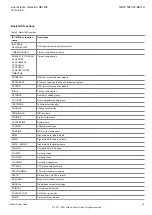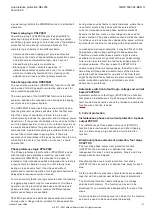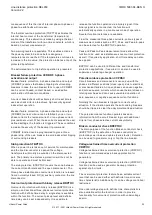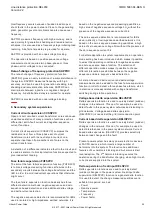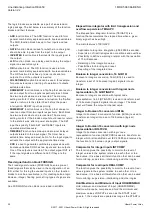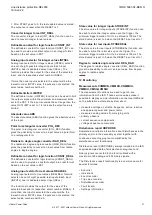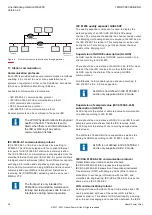
a power swing inhibits the ZMRPSB function, to allow fault
clearance.
Power swing logic PSLPSCH
SEMOD131350-4 v5
Power Swing Logic (PSLPSCH) provides possibility for
selective tripping of faults on power lines during system
oscillations (power swings or pole slips), when the distance
protection function should normally be blocked. The
complete logic consists of two different parts:
• Communication and tripping part: provides selective
tripping on the basis of special distance protection zones
and a scheme communication logic, which are not
blocked during the system oscillations.
• Blocking part: blocks unwanted operation of
instantaneous distance protection zone 1 for oscillations,
which are initiated by faults and their clearing on the
adjacent power lines and other primary elements.
Out-of-step protection OOSPPAM
GUID-BF2F7D4C-F579-4EBD-9AFC-7C03296BD5D4 v8
The out-of-step protection (OOSPPAM ) function in the IED
can be used for both generator protection and as well for
line protection applications.
The main purpose of the OOSPPAM function is to detect,
evaluate, and take the required action during pole slipping
occurrences in the power system.
The OOSPPAM function detects pole slip conditions and
trips the generator as fast as possible, after the first pole-
slip if the center of oscillation is found to be in zone 1,
which normally includes the generator and its step-up power
transformer. If the center of oscillation is found to be further
out in the power system, in zone 2, more than one pole-slip
is usually allowed before the generator-transformer unit is
disconnected. A parameter setting is available to take into
account the circuit breaker opening time. If there are
several out-of-step relays in the power system, then the one
which finds the center of oscillation in its zone 1 should
operate first.
Phase preference logic PPL2PHIZ
GUID-39785DEB-E5D7-447C-977B-9E940CA8E774 v2
The Phase preference logic function (PPL2PHIZ) is used
with the high speed distance protection, quad and mho
characteristic (ZMFPDIS). It is intended to be used in
isolated or high impedance earthed networks where there is
a requirement to operate on only one of the faulty lines
during a cross-country fault. It can be used without
preference to restrain operation for single earth faults with a
delayed zero-sequence current release.
For cross-country faults, the logic selects either the leading
or lagging phase-earth loop for measurement. It initiates
operation on the preferred phase based on the selected
phase preference scheme. A number of different phase
preference schemes are available.
PPL2PHIZ provides an additional phase selection criteria,
namely under voltage criteria, suitable for phase selection
during cross-country faults. In radial networks, where there
is no fault current in the phase with the external fault,
current or impedance based phase selection methods
become ineffective. Hence, only voltage can be used for
phase selection. The phase selection result will be the same
for all bays on a bus since the voltage is the same, which is
an important condition for operating with phase preference.
In meshed and stronger networks, it may be difficult to find
appropriate under-voltage settings for phase selection.
Therefore an automatic phase selection logic is made
available which works in parallel with a set under-voltage
criterion in order to detect the two faulty phases even for
complex networks. If for any reason the PPL2PHIZ is
unable to detect the two faulty phases, then after a short
time delay all three phase-to-earth loops of the distance
protection will be released for operation. The final result
might be that both faulty feeders are disconnected. In other
words, protection operation is prioritized over strict
adherence to preference.
Automatic switch onto fault logic, voltage and current
based ZCVPSOF
M13829-3 v4
Automatic switch onto fault logic (ZCVPSOF) is a function
that gives an instantaneous trip at closing of breaker onto a
fault. A dead line detection check is provided to activate the
function when the line is dead.
5. Current protection
Instantaneous phase overcurrent protection, 3-phase
output PHPIOC
M12910-3 v15
The instantaneous three phase overcurrent (PHPIOC)
function has a low transient overreach and short tripping
time to allow use as a high set short-circuit protection
function.
Directional phase overcurrent protection, four steps
OC4PTOC
M12846-3 v18
The four step phase overcurrent protection function
(OC4PTOC) has an inverse or definite time delay
independent for step 1 and 4 separately. Step 2 and 3 are
always definite time delayed.
Directional phase overcurrent protection, four steps
(OC4PTOC) has an inverse or definite time delay for each
step.
All IEC and ANSI inverse time characteristics are available
together with an optional user defined time characteristic.
The directional function needs voltage as it is voltage
polarized with memory. The function can be set to be
directional or non-directional independently for each of the
steps.
A second harmonic blocking level can be set for the function
and can be used to block each step individually.
Line distance protection REL650
1MRK 506 384-BEN H
Version 2.2
Hitachi Power Grids
21
© 2017 - 2021 Hitachi Power Grids. All rights reserved
Содержание REL650 series
Страница 1: ...Relion 650 SERIES Line distance protection REL650 Version 2 2 Product guide...
Страница 117: ...117...













